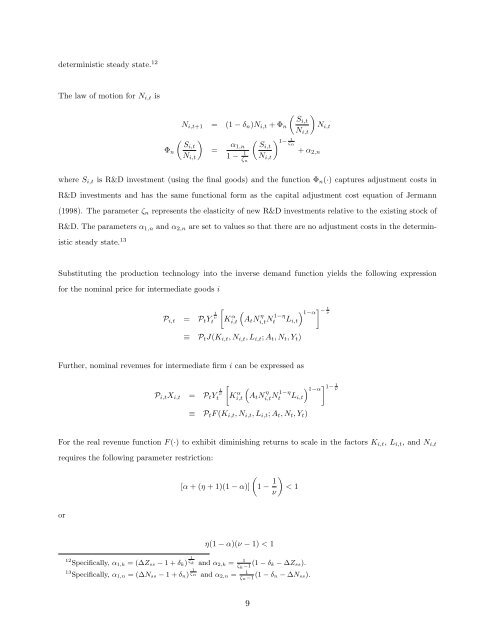Equilibrium Growth, Inflation, and Bond Yields - Duke University's ...
Equilibrium Growth, Inflation, and Bond Yields - Duke University's ...
Equilibrium Growth, Inflation, and Bond Yields - Duke University's ...
Create successful ePaper yourself
Turn your PDF publications into a flip-book with our unique Google optimized e-Paper software.
deterministic steady state. 12<br />
The law of motion for Ni,t is<br />
� �<br />
Si,t<br />
Ni,t+1 = (1 − δn)Ni,t + Φn Ni,t<br />
Ni,t<br />
� �<br />
� � 1 1− ζn<br />
Si,t<br />
Si,t<br />
Φn =<br />
+ α2,n<br />
Ni,t<br />
Ni,t<br />
α1,n<br />
1 − 1<br />
ζn<br />
where Si,t is R&D investment (using the final goods) <strong>and</strong> the function Φn(·) captures adjustment costs in<br />
R&D investments <strong>and</strong> has the same functional form as the capital adjustment cost equation of Jermann<br />
(1998). The parameter ζn represents the elasticity of new R&D investments relative to the existing stock of<br />
R&D. The parameters α1,n <strong>and</strong> α2,n are set to values so that there are no adjustment costs in the determin-<br />
istic steady state. 13<br />
Substituting the production technology into the inverse dem<strong>and</strong> function yields the following expression<br />
for the nominal price for intermediate goods i<br />
Pi,t = PtY 1<br />
�<br />
ν<br />
t K α �<br />
i,t AtN η 1−η<br />
i,tNt Li,t<br />
≡ PtJ(Ki,t, Ni,t, Li,t; At, Nt, Yt)<br />
Further, nominal revenues for intermediate firm i can be expressed as<br />
Pi,tXi,t = PtY 1<br />
�<br />
ν<br />
t K α �<br />
i,t AtN η 1−η<br />
i,tNt Li,t<br />
≡ PtF (Ki,t, Ni,t, Li,t; At, Nt, Yt)<br />
� 1−α � − 1<br />
ν<br />
� 1−α � 1− 1<br />
ν<br />
For the real revenue function F (·) to exhibit diminishing returns to scale in the factors Ki,t, Li,t, <strong>and</strong> Ni,t<br />
requires the following parameter restriction:<br />
or<br />
�<br />
[α + (η + 1)(1 − α)] 1 − 1<br />
�<br />
< 1<br />
ν<br />
η(1 − α)(ν − 1) < 1<br />
12<br />
Specifically, α1,k = (∆Zss − 1 + δk) 1<br />
ζk <strong>and</strong> α2,k = 1<br />
ζk−1 (1 − δk − ∆Zss).<br />
1<br />
13<br />
Specifically, α1,n = (∆Nss − 1 + δn) ζn 1<br />
<strong>and</strong> α2,n = (1 − δn − ∆Nss).<br />
ζn−1<br />
9
















